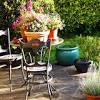
How high should a raised veg bed be? Optimum Size for Raised Beds
Aim for a minimum height of 6 inches (15cm), while up to a foot (30cm) is ideal for root crops. Make sure to leave enough space for access between beds. About two feet (60cm) wide is ideal.
How deep should a garden box be for vegetables? For most plants, a 6-to 8-inch-deep planter box is sufficient. The depth may vary for some vegetables, however. Turnips, cucumbers, broccoli, beets, lettuce and green onions can all grow well in a planter box at that depth, but other vegetables, like cabbage, need a deeper depth of at least 10 inches.
Can a raised garden bed be too deep? If it is too deep, the whole thing can collapse due to the weight of wet soil. So, how deep should you make raised garden beds? You should make raised garden beds at least 12 inches (30 centimeters) deep. Some plants with longer roots will require soil up to 36 inches (90 centimeters) deep.
What do you put at the bottom of a raised garden bed? You can fill the bottom of a raised garden bed with a number of organic materials, including straw, grass clippings, wood chips, and leaves. Place cardboard – or any suitable weed barrier material – over this organic layer, weighing it down with a few bricks or pegs.